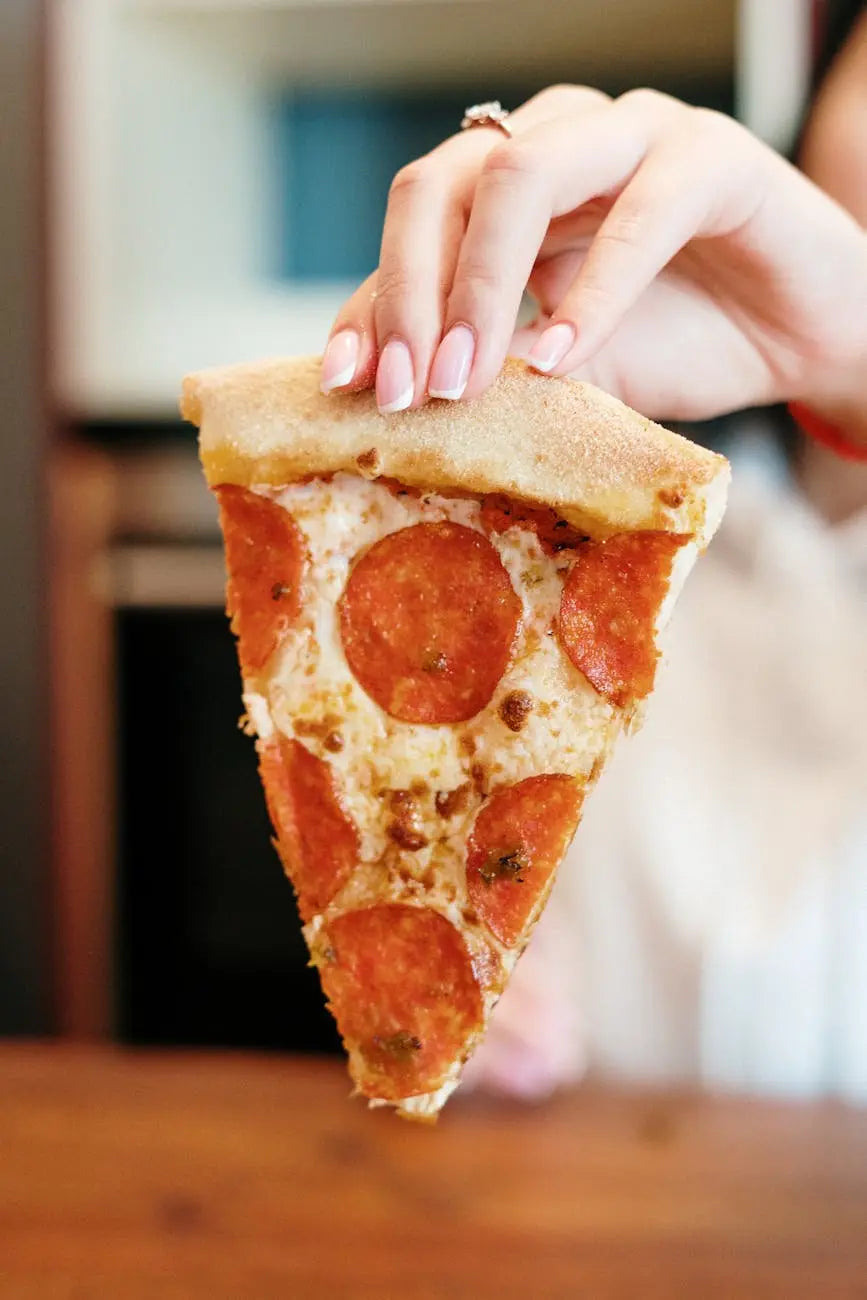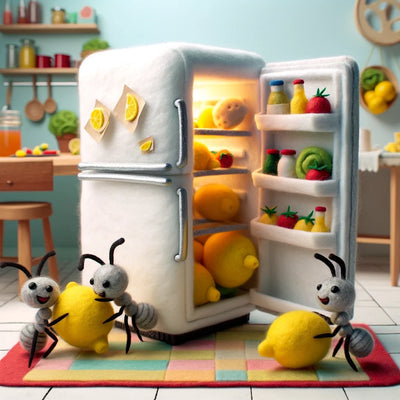The Science of Food Storage
Understanding the science behind food storage is key to extending the shelf life of your favorite meals, including that delicious pie you may not finish in one sitting. When it comes to food preservation, several factors play a role in keeping your meals safe and tasty for as long as possible.
Understanding Food Spoilage
Food spoilage is a natural process caused by microorganisms like bacteria, yeasts, and molds, as well as enzymatic reactions within the food itself. These factors can lead to changes in taste, color, smell, and texture, indicating that the food is no longer suitable for consumption. Your leftover pizza, for instance, is susceptible to these changes over time, especially if not stored correctly.
Environmental factors such as temperature, humidity, and light can accelerate the spoiling process. This is why it's crucial to limit these elements by storing foods like pizza in the cool, dark environment of your fridge. For more on this topic, explore the intricacies of unlocking the secrets discover how long rice can stay fresh in the fridge.
Importance of Proper Refrigeration
Proper refrigeration slows down the growth of harmful microorganisms and enzymatic reactions, thereby preserving the quality and safety of your food. The ideal temperature for a refrigerator is at or below 40°F (4°C), where the rate of bacterial growth is significantly reduced.
When you place your pizza in the fridge, you're effectively retarding the spoilage process, extending the period during which the pizza remains safe to eat. Each type of food has its own shelf life within this chilled environment, and it's useful to know these specifics for effective food management. For example, uncover the longevity of pork in the chilled confines of your refrigerator by reading preserving the freshness how long does pork last in the fridge.
In addition to maintaining the right temperature, proper airflow and humidity levels also contribute to prolonging the freshness of foods. With advancements in refrigeration technology, modern fridges offer features that help maintain these conditions, such as humidity-controlled crispers and multi-airflow systems. Dive into the latest fridge features and how they benefit food preservation in our guide to upgrade your kitchen the benefits of freezer on top refrigerators.
By understanding the science of food spoilage and the importance of proper refrigeration, you can make informed decisions about storing your food, including your beloved pizza. These principles not only help you enjoy your meals for longer but also contribute to reducing food waste. Continue exploring the topic of pizza storage with our focused guide on unlocking the mystery how long does pizza really last in the fridge, and ensure your leftovers stay delicious and safe to eat.
Decoding Pizza Storage
Understanding the longevity of pizza in your fridge isn't just about satisfying those late-night cravings—it's about ensuring you enjoy your leftover slices safely.
How Long Does Pizza Last in the Fridge?
The shelf life of pizza in the fridge typically ranges from 3 to 4 days. Properly refrigerated, pizza remains safe to eat within this timeframe, but the quality may begin to decline after the first couple of days. For an in-depth look at the shelf life of other foods, consider reading about how long rice can stay fresh in the fridge.
| Pizza Type | Fridge Shelf Life |
|---|---|
| All Types | 3-4 Days |
Factors Affecting Pizza Shelf Life
Several factors can influence how long your pizza remains good in the fridge:
- Toppings: Meat toppings tend to spoil faster than vegetables or cheese. This variability in topping durability can affect overall freshness.
- Storage Method: Airtight containers or proper wrapping can extend the pizza's fridge life by reducing exposure to bacteria and air.
- Initial Temperature: If the pizza sat out at room temperature for more than two hours before refrigeration, the risk of spoilage increases.
- Fridge Temperature: The optimal fridge temperature for storing pizza is below 40°F. Any higher and you risk accelerating spoilage.
For those wondering about freezing pizza for extended preservation, visit never waste pizza again freeze your slices like a pro.
Remember, these guidelines are for general reference. Always trust your senses and check for signs of spoilage before indulging in refrigerated pizza. You can learn more about checking the freshness of your pizza in the section keep calm and pizza on unveiling the shelf life of refrigerated pizza.
Shelf Life of Different Pizza Types
When it comes to refrigerating leftovers, pizza is no exception. Depending on the type of pizza you have, the shelf life in the fridge can vary. Let's explore how long different types of pizza last when stored properly in the refrigerator.
Cheese Pizza
Cheese pizza, with its simpler toppings, can last in the fridge for a relatively longer period compared to its topped counterparts. When stored in an airtight container or wrapped tightly in aluminum foil or plastic wrap, cheese pizza can maintain its quality for up to four days.
| Pizza Type | Shelf Life in Fridge |
|---|---|
| Cheese Pizza | 3-4 Days |
Meat Lovers Pizza
Pizzas with meat toppings such as pepperoni, sausage, or bacon generally have a shorter fridge life due to the meat's susceptibility to spoilage. It's important to refrigerate these pizzas as soon as possible. Typically, a meat lovers pizza can be safe to consume for up to three days when stored correctly.
| Pizza Type | Shelf Life in Fridge |
|---|---|
| Meat Lovers Pizza | 2-3 Days |
For more information on storing meat and understanding its shelf life, you can read preserving the freshness: how long does pork last in the fridge.
Veggie Pizza
Veggie pizzas, topped with an assortment of vegetables, can also be kept in the fridge for 3-4 days. The water content in vegetables can impact the texture, so it's best to consume sooner rather than later to enjoy it at its best quality.
| Pizza Type | Shelf Life in Fridge |
|---|---|
| Veggie Pizza | 3-4 Days |
When you're ready to eat your refrigerated pizza, remember that reheating it properly can help restore some of the fresh-baked qualities. If you're curious about preserving pizza for even longer, freezing is an option. Learn how to do so in our guide never waste pizza again: freeze your slices like a pro.
By understanding the different shelf lives of various pizza types, you can ensure that you enjoy your leftovers safely and at their best possible quality. Always check for any signs of spoilage before consuming, and when in doubt, it's safer to discard any pizza that's been stored longer than the recommended time. If you're looking for more tips on checking the freshness of your pizza, take a look at our article keep calm and pizza on: unveiling the shelf life of refrigerated pizza.
Proper Pizza Storage Tips
To unravel the enigma of 'unlocking the mystery how long does pizza really last in the fridge,' you must start with the best practices for storing pizza. Proper storage is not just about prolonging the life of your pizza but also preserving its taste and quality.
Best Practices for Storing Pizza
When you store pizza in the fridge, a few key steps can make all the difference in keeping it fresh and delicious. Here's what you should do:
- Allow pizza to cool to room temperature before refrigerating to prevent condensation within the storage container.
- Use airtight containers to store the pizza slices. This prevents moisture loss and keeps other fridge odors at bay.
- Place a paper towel at the bottom of the container before adding pizza. This will absorb excess oil and moisture.
- If you're stacking slices, separate them with a layer of parchment or wax paper to prevent sticking.
- Label your container with the date to keep track of how long the pizza has been stored.
By following these steps, you can help ensure that your pizza remains as fresh as possible during its stint in the fridge. If you're interested in other food storage insights, you might explore articles like unlocking the secrets discover how long rice can stay fresh in the fridge or preserving the freshness how long does pork last in the fridge.
Recommended Storage Containers
The right storage container is vital for maintaining the quality of your refrigerated pizza. Here are some options to consider:
- Airtight Plastic Containers: These are the most common choice and come in various sizes to accommodate different pizza amounts.
- Glass Containers with Lids: Glass is an excellent option as it doesn't absorb odors and is easy to clean.
- Specialized Pizza Storage Bags: Some stores offer resealable bags designed specifically for pizza slices, which can be a space-saving alternative.
| Container Type | Pros | Cons |
|---|---|---|
| Airtight Plastic | Lightweight, affordable | Can retain stains and odors |
| Glass with Lids | Odor-resistant, durable | Heavier, potentially more costly |
| Pizza Storage Bags | Space-efficient, designed for slices | Less sturdy than rigid containers |
Choosing the right container depends on your personal preferences and the amount of pizza you need to store. For those passionate about their food storage, you might find joy in exploring articles like chill your beauty routine the power of mini makeup fridges or upgrade your kitchen the benefits of freezer on top refrigerators.
Proper storage techniques and containers are essential for extending the shelf life of your pizza. By adhering to these tips, you can enjoy your leftover slices for as long as possible without compromising on taste or safety. If you're curious about freezing pizza for even longer preservation, consider reading never waste pizza again freeze your slices like a pro.
Checking Pizza Freshness
Ensuring the freshness of your pizza is essential for both taste and health. It is important to be able to identify the signs of spoiled pizza to avoid consuming food that could be harmful.
Signs of Spoiled Pizza
When assessing whether your pizza has gone bad, there are several indicators to look out for:
- Odor: A notable change in smell is a clear sign that your pizza is no longer fresh. If it emits a sour or unpleasant odor, it's best to err on the side of caution and not consume it.
- Appearance: Visible mold or discoloration on the crust, cheese, or toppings is a sure sign of spoilage. Mold can appear in a variety of colors, including white, green, or black.
- Texture: If the crust has become particularly hard and dry beyond what is typical for refrigerated pizza, or if the cheese and toppings are slimy or overly moist, it's time to discard it.
- Taste: If you're unsure based on the other factors, a small taste test can be telling. However, this should be a last resort, and only a tiny amount should be tasted. If the flavor is off or sour, do not eat any more.
When to Discard Leftover Pizza
As a general guideline, leftover pizza should be discarded if it has been stored in the fridge for more than three to four days. Here's a quick reference table for pizza shelf life:
| Pizza Type | Maximum Days in Fridge |
|---|---|
| Cheese Pizza | 3-4 |
| Meat Lovers Pizza | 3-4 |
| Veggie Pizza | 3-4 |
If you notice any of the above signs of spoilage, or if the pizza has been refrigerated beyond this time frame, it is safest to discard it. Consuming spoiled food can lead to foodborne illnesses, which is why it's crucial to pay attention to these signs.
For more insights into pizza storage and ensuring its longevity, explore our comprehensive guide on never waste pizza again freeze your slices like a pro, or learn about the shelf life of other refrigerated foods like rice in unlocking the secrets discover how long rice can stay fresh in the fridge and pork in preserving the freshness how long does pork last in the fridge. If you're curious about how to upgrade your refrigeration system for optimal food storage, check out articles such as upgrade your kitchen the benefits of freezer on top refrigerators and sleek and efficient white bottom freezer refrigerators for style conscious homeowners.
Reheating Pizza Safely
Once you've solved the enigma of how long pizza really lasts in the fridge, the next step is reheating it properly to enjoy a slice that is almost as good as when it was first baked. Here's how you can warm up your pizza while maintaining its taste and texture.
Methods for Reheating Pizza
There are several ways to reheat pizza, with each method offering different benefits:
- Oven: Preheat your oven to around 375°F and place the pizza on a baking sheet. Reheat for 10 to 15 minutes. This method helps retain the crispy crust.
- Toaster Oven: Similar to the oven method, but more energy-efficient for reheating one or two slices.
- Skillet: Heat a skillet over medium flame and place the pizza slice in it. Cover with a lid to melt the cheese and warm the toppings without overcooking the base.
- Microwave: For a quick reheating, use the microwave but be mindful that it can make the crust soft. A trick is to place a cup of water alongside the pizza to help keep the crust from getting chewy.
| Method | Temperature | Time |
|---|---|---|
| Oven | 375°F | 10-15 min |
| Toaster Oven | - | Varies |
| Skillet | Medium Flame | 5-8 min |
| Microwave | High | 30-45 sec per slice |
Tips for Retaining Pizza Quality
To ensure your pizza tastes as good as when it was fresh, consider these tips:
- Avoid Overheating: Reheat just until the cheese is melted to avoid drying out the pizza.
- Use a Preheated Pan: If using an oven or toaster oven, preheat the pan for a crisper crust.
- Hydrate: A small amount of water in the microwave can prevent the crust from becoming rubbery.
- Covering: In a skillet, covering the pizza can create a steamy environment that warms the toppings and melts the cheese without sacrificing the crust's texture.
By following these methods and tips, you can enjoy your leftover pizza with nearly the same quality as when it was freshly made. Whether you're a foodie, a homeowner, or an entertainer, these reheating techniques will help you savor every last slice. Don't forget to check out our guide to never waste pizza again by freezing your slices for tips on preserving your pizza for even longer.
FAQs About Pizza Storage
When it comes to preserving your favorite slices, understanding the best ways to store pizza can ensure that every piece tastes as good as the first. Here are answers to common questions about how to keep your pizza fresh.
Can You Freeze Pizza?
Yes, you can freeze pizza, and doing so can significantly extend its shelf life. Frozen pizza can maintain its quality for 1-2 months when stored properly. To freeze pizza, ensure that it's cooled to room temperature to prevent condensation and ice crystals. Wrap individual slices in foil or plastic wrap, and then place them in an airtight container or a heavy-duty freezer bag. For more detailed instructions on freezing pizza, visit our guide on never waste pizza again freeze your slices like a pro.
How to Store Pizza for Longevity?
To maximize the longevity of pizza in the fridge, follow these steps:
- Allow the pizza to cool to room temperature within two hours of baking to prevent bacterial growth.
- Place the pizza in an airtight container to maintain freshness and prevent moisture loss. Shallow containers are preferable to limit air exposure.
- Keep the pizza away from strong-smelling foods in the fridge to avoid flavor transfer.
- Set your refrigerator to a temperature below 40°F (4°C) to inhibit bacterial growth.
By following proper storage techniques, pizza can last in the fridge for 3-4 days. Always check for signs of spoilage before consumption. For additional tips on how to keep your pizza tasting great in the fridge, check out our article on savor the slice how long can you enjoy pizza stored in the fridge.
Remember, the key to keeping your pizza delicious is understanding the principles of food storage and applying them effectively. Whether you're a homeowner or a chef, proper pizza storage is essential for preserving your meal.
Get Your Upgrade or New Addition at Fridge.com
Shop the world's best brands at Fridge.com.
Whether you're searching for your perfect fridge, freezer, wine fridge, beer fridge, ice maker, or kegerator, we have what you need.
We also have tons of awesome articles about kitchen stuff and home news. Enhance your home, garage, backyard, patio, and office with the coolest essentials. With every necessary type of residential refrigerator or freezer in our collection, we've got you covered.
Elevate your game and shop now at Fridge.com!






